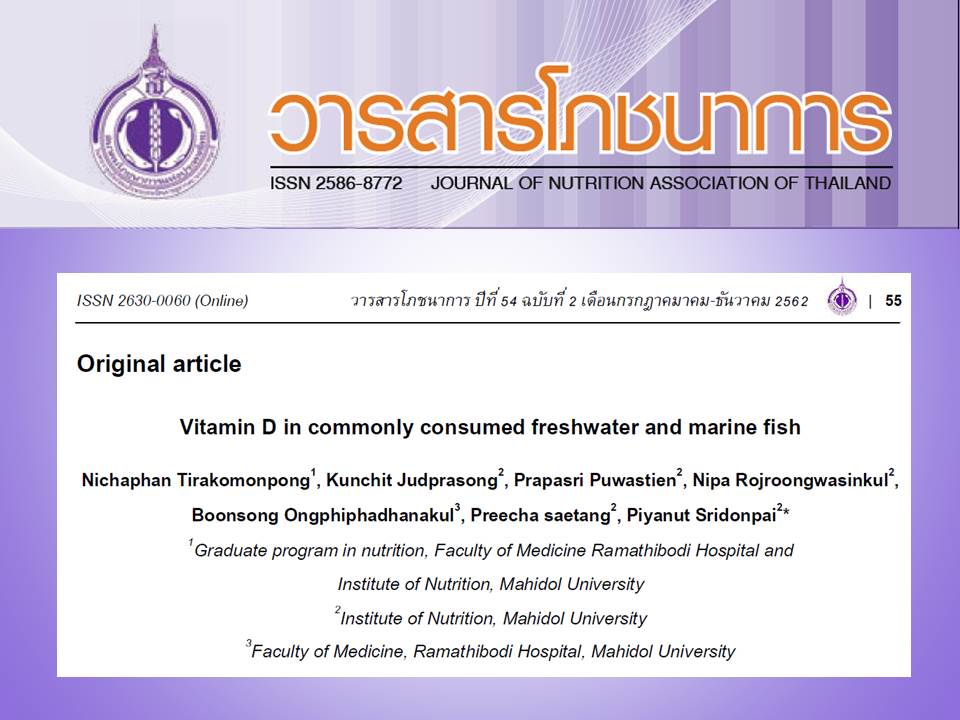วิตามินดีในปลาน้ำจืดและปลาน้ำเค็มที่นิยมบริโภค
คำสำคัญ:
วิตามินดี, ปลาน้ำจืด, ปลาน้ำเค็มบทคัดย่อ
การขาดวิตามินดีเป็นปัญหาสุขภาพสำคัญของคนทั่วโลก ปลานับว่าเป็นแหล่งสำคัญของโปรตีนที่คนไทยนิยมบริโภค แต่ยังไม่มีรายงานข้อมูลของวิตามินดี การศึกษานี้จึงมีวัตถุประสงค์เพื่อจัดทำฐานข้อมูลวิตามินดีในปลาน้ำจืดและปลาน้ำเค็มที่นิยมบริโภค และเพื่อค้นหาชนิดของปลาที่เป็นแหล่งของวิตามินดีที่ควรนำมาส่งเสริมการบริโภค ดำเนินการศึกษาปลา 10 ชนิด ด้วยการคัดเลือกปลาน้ำจืดและปลาทะเลที่นิยมบริโภคอย่างละ 5 ชนิด โดยซื้อจากตลาด 3 แหล่งใหญ่ ตลาดละ 3 ร้านค้า เตรียมตัวอย่างด้วยวิธีที่นิยมทำในครัวเรือน นำส่วนที่กินได้มาปั่นให้เป็นเนื้อเดียวกัน นำไปทำให้แห้งด้วยระบบแช่เยือกแข็ง และปั่นให้ละเอียดอีกครั้งหนึ่ง เก็บในซองอลูมิเนียมที่ -20oC จนกว่าจะวิเคราะห์วิตามินดีและความชื้น วิเคราะห์ปริมาณวิตามิน D2 และ D3 ด้วยเทคนิค HPLC ตามวิธีมาตรฐานสากล (AOAC 2016, 995.05) ผลการศึกษาพบว่าในปลาที่ศึกษาทั้งหมดมีวิตามิน D3 เป็นหลัก คิดเป็นร้อยละ 82-100 ปลาตะเพียน ปลาทับทิม และปลานิล พบว่ามีวิตามินดีสูงมาก (48.5, 31.0, 19.8 ไมโครกรัมต่อ 100 กรัมน้ำหนักสด ตามลำดับ) ปลาดุกและปลาช่อนพบค่าวิตามินดีต่ำ 2.4 และ 5.7 ไมโครกรัมต่อ 100 กรัม สำหรับปลาทะเลพบวิตามินดีต่ำตั้งแต่ 2.9 - 4.7 ไมโครกรัมต่อ100 กรัม ปลาน้ำจืดที่อยู่อาศัยอยู่บริเวณผิวน้ำ พบว่ามีวิตามินดีสูง การบริโภคปลาตะเพียน ปลาทับทิม และปลานิล เพียงหนึ่งหน่วยบริโภค (55 กรัม หรือ 3-4 ช้อนโต๊ะ) ได้รับวิตามินดีสูงมาก คิดเป็นร้อยละ 218-534 ของความต้องการวิตามินดีต่อวัน ดังนั้นการบริโภคปลาเหล่านี้เป็นประจำร่วมกับการได้รับแสงแดดสม่ำเสมอจะช่วยลดความเสี่ยงหรือป้องกันการขาดวิตามินดีได้
เอกสารอ้างอิง
Macdonald HM. Contributions of sunlight and diet to vitamin D status. Calcif Tissue Int. 2013; 92(2):163-76.
Tian XQ, Chen TC, Matsuoka L, Wortsman J, Holick M. Kinetic and thermodynamic studies of the conversion of previtamin D3 to vitamin D3 in human skin. J Biol Chem. 1993; 268(20):14888-92.
Wacker C, Prkno A, Brunkhorst FM, Schlattmann P. Procalcitonin as a diagnostic marker for sepsis: a systematic review and meta-analysis. The Lancet Infect Dis. 2013; 13(5):426-35.
Holick MF. Vitamin D deficiency. N Engl J Med. 2007; 357(3):266-81.
Borradale D, Kimlin M. Vitamin D in health and disease: an insight into traditional functions and new roles for the ‘sunshine vitamin’. Nutr Res Rev. 2009; 22(2):118-36.
Sriussadaporn S, Supranee C, Sirichakwal P, Puwastien P, et al. Dietary Reference Intake for Thais 2003. The War Veterans Organization Publishers; 2003:209-33.
Grant WB, Garland CF. Evidence supporting the role of vitamin D in reducing the risk of cancer. J Intern Med. 2002; 252(2):178-9.
Munger KL, Levin LI, Hollis BW, Howard NS, Ascherio A. Serum 25-hydroxyvitamin D levels and risk of multiple sclerosis. JAMA. 2006; 296(23):2832-8.
Urashima M, Segawa T, Okazaki M, Kurihara M, Wada Y, Ida H. Randomized trial of vitamin D supplementation to prevent seasonal influenza A in schoolchildren. Am J Clin Nutr. 2010; 91(5):1255-60.
Zittermann A. Vitamin D and disease prevention with special reference to cardiovascular disease. Prog Biophys Mol Biol. 2006; 92(1):39-48.
Holick MF, Chen TC. Vitamin D deficiency: a worldwide problem with health consequences. Am J Clin Nutr. 2008; 87(4):1080S-6S.
Khor GL, Chee WS, Shariff ZM, Poh BK, Arumugam M, Rahman JA, et al. High prevalence of vitamin D insufficiency and its association with BMI-for-age among primary school children in Kuala Lumpur, Malaysia. BMC Public Health. 2011; 11(1):95.
Chailurkit L-O, Aekplakorn W, Ongphiphadhanakul B. Regional variation and determinants of vitamin D status in sunshine-abundant Thailand. BMC Public Health. 2011; 11(1):853.
Reesukumal K, Manonukul K, Jirapongsananuruk O, Krobtrakulchai W, Hanyongyuth S, Chatsiricharoenkul S, et al. Hypovitaminosis D in healthy children in Central Thailand: prevalence and risk factors. BMC Public Health. 2015; 15(1):248.
Nimitphong H, Holick MF. Vitamin D status and sun exposure in Southeast Asia. Dermatoendocrinol. 2013; 5(1):34-7.
Schmid A, Walther B. Natural vitamin D content in animal products. Adv Nutr.
; 4(4):453-62.
Lu Z, Chen T, Zhang A, Persons K, Kohn N, Berkowitz R, et al. An evaluation of the vitamin D3 content in fish: Is the vitamin D content adequate to satisfy the dietary requirement for vitamin D? J Steroid Biochem Mol Biol. 2007; 103(3-5):642-4.
Mattila P, Piironen V, Uusi-Rauva E, Koivistoinen P. Cholecalciferol and 25-hydroxycholecalciferol contents in fish and fish products. J Food Compost Anal. 1995; 8(3):232-43.
Rao DS, Raghuramulu N. Is vitamin D redundant in an aquatic habitat? J Nutr Sci Vitaminol. 1999; 45(1):1-8.
Food and Agriculture Organization of the United Nations: Fisheries and Aquaculture Department. 2019 Jun [Cited 2019 Jun 15]. Available from: http://www.fao.org/fishery/facp/THA/en
National Bureau of Agricultural Commodity and Food Standards, Ministry of Agriculture and Cooperative. Food Consumption Data of Thailand; 2016.
Greenfield H, Southgate DA. Food composition data: production, management, and use: Food & Agriculture Org.; 2003.
AOAC. Official Methods of Analysis of the Association of Official Analytical Chemists (20th edition). Association of Official Analytical Chemists, Arlington, VA, U.S.A.; 2016.
AOAC 2002: Association of Official Analytical Chemists (AOAC). Guidelines for Single Laboratory Validation of Chemical Methods for Dietary Supplements and Botanicals. 2019 Jun [Cited 2019 Jun 15]. Available from: https://members.aoac.org/AOAC_Docs/StandardsDevelopment/SLV_Guidelines_Dietary_Supplements.pdf
Bilodeau L, Dufresne G, Deeks J, Clément G, Bertrand J, Turcotte S, et al. Determination of vitamin D3 and 25-hydroxyvitamin D3 in foodstuffs by HPLC UV-DAD and LC–MS/MS. J Food Compost Anal. 2011; 24(3):441-8.
Schmid A, Walther B. Natural Vitamin D Content in Animal Products. Adv Nutr. 2013; 4(4):453–462.
Pierens S, Fraser D. The origin and metabolism of vitamin D in rainbow trout. J Steroid Biochem Mol Biol. 2015; 145:58-64.
Lu Z, Chen TC, Zhang A, Persons KS, Kohn N, Berkowitz R, Martinello S, Holick MF. An evaluation of the vitamin D3 content in fish: Is the vitamin D content adequate to satisfy the dietary requirement for vitamin D? J Steroid Biochem Mol Biol. 2007; 103:642-4.
Mattila P, Piironen V, Haapala R, Hirvi T, Uusi-Rauva E. Possible factors responsible for the high variation in the cholecalciferol contents of fish. J Agric Food Chem. 1997; 45(10):3891-6.
Thai Notification of the Ministry of Public Health (No. 182) B.E. 2541(1998) Re: Nutrition Labelling; 1998.

ดาวน์โหลด
เผยแพร่แล้ว
รูปแบบการอ้างอิง
ฉบับ
ประเภทบทความ
สัญญาอนุญาต
บทความที่เผยแพร่ในวารสารโภชนาการ เป็นลิขสิทธิ์ของสมาคมโภชนาการแห่งประเทศไทยฯ


